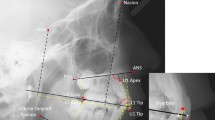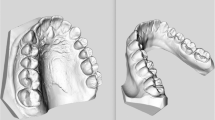Abstract
The purposes of this study were to establish normative data for mesiodistal tooth crown diameters and arch dimensions in Mongolian adults and to compare them with those of Japanese adults. The study materials comprised dental casts of 100 modern Mongolian and 100 Japanese subjects (50 males, 50 females for each) with Angle Class I normal occlusion. The mean ages were 20 years 8 months for the Mongolian subjects and 20 years 0 months for the Japanese subjects. On the dental casts, the mesiodistal tooth crown diameters (excluding wisdom teeth) and dental arch dimensions were measured. The following arch dimensions were measured: inter-canine lingual, inter-premolar lingual, inter-molar lingual, inter-molar central, coronal arch length, basal arch length, and basal arch width. In the Mongolian samples, significant sex differences were noted, and most of the items were significantly larger in males than in females. Significant differences between the Mongolian and Japanese samples were mainly noted in the premolar and molar regions, rather than in the anterior region, and were significantly smaller in the Mongolian samples. In the Mongolian samples, the molar section widths and basal arch width and length were significantly larger in males and females compared with the Japanese samples. These results suggest that the tooth crown size and arch dimensions in the Mongolian samples differed from those in the Japanese samples, and that establishment of the clinical norm for Mongolian adults might be helpful in formulating treatment plans for Mongolian patients, given that these parameters are the basic tools for diagnosis.

Similar content being viewed by others
Abbreviations
- I1:
-
Central incisor
- I2:
-
Lateral incisor
- C:
-
Canine
- P1:
-
First premolar
- P2:
-
Second premolar
- M1:
-
First molar
- M2:
-
Second molar
References
Chimge N, Batsuuri J. Interethnic genetic differentiation, HLA Class I antigens in the population of Mongolia. Am J Hum Biol. 1999;11:603–18.
Hanihara K. Mongoloid dental complex in the deciduous dentition. J Anthropol Soc Nippon. 1966;74:61–72.
Hanihara K. Mongoloid dental complex in the permanent dentition. In: VIIIth Congress of Anthropological and Ethnological Sciences. 1968; Tokyo and Kyoto, 298-300.
Turner II CG. Late Pleistocene and Holocene population history of east Asia based on dental variation. Am J Phys Anthropol. 1987;73:305–21.
Hillson S. Dental anthropology. Cambridge: Cambridge university press; 1996. p. 101–2.
Scott RG, TurnerII CG. The anthropology of modern human teeth. Cambridge: Cambridge university press; 1997. p. 270–1.
Iscan MY. The emergence of dental anthropology. Am J Phys Anthropol. 1989;78:1.
Moorrees CFA, Thomsen SØ, Jensen E, Yen PKJ. Mesiodistal crown diameters of the deciduous and permanent teeth in individuals. J Dent Res. 1957;36:39–47.
Matsumura H. Dental characteristics affinities of the prehistoric to the modern Japanese with the East Asians, American Natives and Australo-Melanesians. Anthropol Sci. 1995;103:235–61.
Hanihara T, Ishida H. Metric dental variation of major human populations. Am J Phys Anthropol. 2005;128:287–98.
Little RM. The Irregularity Index: a quantitative score of mandibular anterior alignment. Am J Orthod. 1975;68:554–63.
Howes AE. A polygon portrayal of coronal and basal arch dimensions in the horizontal plane. Am J Orthod. 1954;40:811–31.
Kayukawa H. Studies on morphology of mandibular overjet. Jpn J Orthod. 1956;15:6–26.
Ling JY, Wong RW. Dental arch width of southern Chinese. Angle Orthod. 2009;79:54–63.
Al-Khateeb SN, Abu Alhaija SJ. Tooth size discrepancies and arch parameters among different malocclusions in a Jordan sample. Angle Orthod. 2006;76:459–65.
Dahlberg G. Statistical methods for medical and biological students. London: George Allen and Unwin Ltd; 1940.
Arya BS, Sayara BS, Thomas D, et al. Relation of sex and occlusion to mesiodistal tooth size. Am J Orthod. 1974;66:479–86.
Alvaran N, Roldan SI, Buschang PH. Maxillary and mandibular arch width of Colombians. Am J Orthod Dentofacial Orthop. 2009;135:649–56.
Al-Khatib AR, Rajion ZA, Masudi SM, Hassan R, Anderson PJ, Townsend GC. Tooth size and dental arch dimensions: a stereophotogrammetric study in Southeast Asian Malays. Orthod Craniofac Res. 2011;14:243–53.
Sofaer JA, Bailit HL, MacLean CJ. A developmental basis for differential tooth reduction during hominid evolution. Evolution. 1971;25:509–17.
Dahlberg AA. The changing dentition of the man. J Amer Dent Assoc. 1945;32:676–90.
Tsuchimochi T, Arai K. Comparison of clinical dental arch form between Japanese and Mongolian subjects with normal occlusion. Orthod Waves Jpn ed. 2012; 69, (in press).
Merz ML, Isaacson RJ, Germane N, Rubenstein LK. Tooth diameters and arch perimeters in a black and white population. Am J Orthod Dentofacial Orthop. 1991;100:53–8.
Reid DJ, Dean MC. Variation in modern human enamel formation times. J Hum Evol. 2006;50:329–46.
Townsend GC, Harris EF, Lesot H, Clauss F, Brook A. Morphogenetic fields within the human dentition: a new clinically relevant synthesis of an old concept. Arch Oral Biol. 2009;54:S34–44.
Bishara SE, Jakobsen JR, Treder J, Nowak A. Arch width changes from 6 weeks to 45 years of age. Am J Orthod Dentfacial Orthop. 1997;111:401–9.
Harris E. A longitudinal study of arch size and form in untreated adults. Am J Orthod Dentfacial Orthop. 1997;111:419–27.
Acknowledgments
The support of the research staff at both the Health Sciences University of Mongolia and The Nippon Dental University School of Life Dentistry Tokyo and Niigata is gratefully acknowledged.
Conflict of interest
The authors declare no conflicts of interest.
Author information
Authors and Affiliations
Corresponding author
Rights and permissions
About this article
Cite this article
Hasegawa, Y., Amarsaikhan, B., Chinvipas, N. et al. Comparison of mesiodistal tooth crown diameters and arch dimensions between modern Mongolians and Japanese. Odontology 102, 167–175 (2014). https://doi.org/10.1007/s10266-013-0130-5
Received:
Accepted:
Published:
Issue Date:
DOI: https://doi.org/10.1007/s10266-013-0130-5




